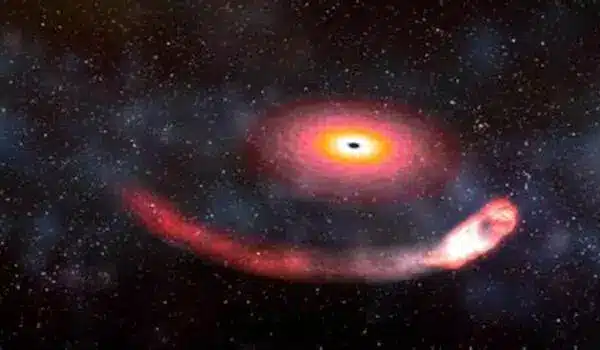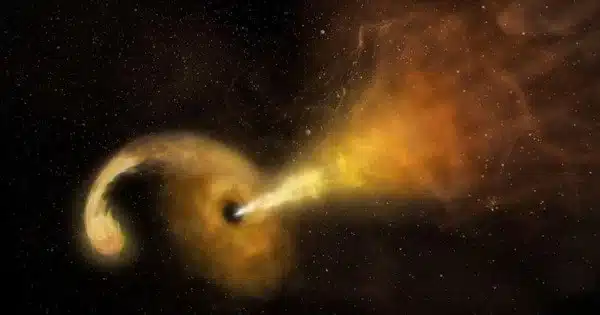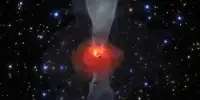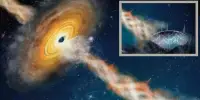A star eating a planet would be a momentous and rare astronomical occurrence, according to astronomers. When a star consumes a planet, it is usually due to the star’s development. Stars, like our Sun, go through several stages of their lives. As a star ages and its hydrogen fuel runs out, it swells into a red giant. During this phase, its outer layers can expand far enough to engulf adjacent solar system planets.
For the first time, scientists have watched a star devouring a planet. In 5 billion years, Earth will face a same fate. When a star runs out of fuel, it expands to a million times its original size, devouring all matter – even planets – in its path. Scientists have observed hints of stars just before, and shortly after, the act of consuming entire planets, but they have never caught one in the act until now.
For the first time, scientists from MIT, Harvard University, Caltech, and other institutions claim in Nature that they have observed a star consuming a planet.
The planetary extinction appears to have occurred in our own galaxy, around 12,000 light-years away, near the eagle-like constellation Aquila. Astronomers discovered an outburst from a star that grew more than 100 times brighter in just 10 days before rapidly fading away. This white-hot flash was strangely followed by a colder, longer-lasting signal. The scientists calculated that this combination could only have resulted from one event: a star devouring a nearby planet.
We are seeing the future of the Earth. If some other civilization was observing us from 10,000 light-years away while the sun was engulfing the Earth, they would see the sun suddenly brighten as it ejects some material, then form dust around it, before settling back to what it was.
Kishalay De
“We were seeing the end-stage of the swallowing,” says lead author Kishalay De, a postdoc in MIT’s Kavli Institute for Astrophysics and Space Research.
What about the world that perished? The scientists believe it was a hot, Jupiter-sized globe that spiraled near, then was drawn into the dying star’s atmosphere, and finally into its core. A similar fate awaits the Earth, though not for another 5 billion years, when the sun is anticipated to burn out and destroy the solar system’s inner planets.
“We are seeing the future of the Earth,” says De. “If some other civilization was observing us from 10,000 light-years away while the sun was engulfing the Earth, they would see the sun suddenly brighten as it ejects some material, then form dust around it, before settling back to what it was.”
The study’s MIT co-authors include Deepto Chakrabarty, Anna-Christina Eilers, Erin Kara, Robert Simcoe, Richard Teague, and Andrew Vanderburg, along with colleagues from Caltech, the Harvard and Smithsonian Center for Astrophysics, and multiple other institutions.

Hot and cold
The team detected the eruption in May 2020. However, it took another year for the scientists to cobble together a hypothesis for what the explosion could be.
The first signal was discovered during a data search conducted by the Zwicky Transient Facility (ZTF) at Caltech’s Palomar Observatory in California. The ZTF is a survey that examines the sky for stars that rapidly change brightness, the pattern of which could be signs of supernovae, gamma-ray bursts, and other stellar occurrences.
De was searching through ZTF data for hints of eruptions in stellar binaries, which are systems in which two stars orbit each other, with one sucking mass from the other and brightening briefly as a result.
“One night, I noticed a star that brightened by a factor of 100 over the course of a week, out of nowhere,” De recalls. “It was unlike any stellar outburst I had seen in my life.”
De went to observations of the same star obtained by the Keck Observatory in Hawaii in the hopes of narrowing down the source with more data. The Keck telescopes collect spectroscopic measurements of starlight that scientists can use to determine the chemical makeup of stars. But what De discovered perplexed him even more. While typical binaries emit stellar material like hydrogen and helium when one star erodes the other, the mystery source did not. Instead, De observed evidence of “unusual molecules” that can only exist at extremely low temperatures.
“These molecules are only seen in stars that are very cold,” De explains. “And when a star shines brighter, it usually gets hotter.” Low temperatures and brighter stars do not mix.”
“A happy coincidence”
It was then clear that the signal was not of a stellar binary. De decided to wait for more answers to emerge. About a year after his initial discovery, he and his colleagues analyzed observations of the same star, this time taken with an infrared camera at the Palomar Observatory. Within the infrared band, astronomers can see signals of colder material, in contrast to the white-hot, optical emissions that arise from binaries and other extreme stellar events.
“That infrared data made me fall off my chair,” De says. “The source was insanely bright in the near-infrared.”
After its initial hot flash, it appeared that the star continued to emit colder radiation throughout the next year. That icy substance was most likely gas from the star that exploded into space and condensed into dust, which was cold enough to be detected at infrared wavelengths. This data revealed that the star was merging with another star rather than brightening due to a supernova explosion.
When the scientists investigated the data further and compared it to measurements collected by NASA’s infrared satellite telescope, NEOWISE, they came to a much more exciting conclusion. They calculated the entire amount of energy emitted by the star since its initial outburst using the collected data and discovered it to be unexpectedly tiny – around 1/1,000 the magnitude of any previous stellar merger seen.
“That means that whatever merged with the star has to be 1,000 times smaller than any other star we’ve seen,” De explains. “It’s also a happy coincidence that Jupiter’s mass is about 1/1,000 that of the sun.” That’s when we discovered we were looking at a planet hurtling into its star.”
The experts were eventually able to explain the original eruption with all of the parts in place. The brilliant, scorching flash was most likely the closing moments of a Jupiter-sized planet being drawn into the inflating atmosphere of a dying star. The outer layers of the star burst away as the planet descended into the star’s core, settling out as frigid dust over the next year.
“For decades, we’ve been able to see the before and after,” De asserts. “Before, when the planets are still very close to their star, and after, when a planet has already been engulfed and the star is massive. What we were lacking was catching the star in the act, with a planet going through its fate in real time. That’s what makes this discovery so thrilling.”
















